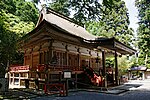| Matsunoo-taisha 松尾大社 | |
|---|---|
 The haiden, at Matsunoo-taisha | |
| Religion | |
| Affiliation | Shinto |
| Deity | Ō-yamagui-no-kami Nakatsu-shima-hime-no-Mikoto Tsukuyomi |
| Location | |
| Location | 3 Arashiyamamiya-chō, Nishikyō-ku, Kyoto, Kyoto Prefecture 〒 616-0024 |
| Geographic coordinates | 35°00′01″N 135°41′07″E / 35.00028°N 135.68528°E |
| Architecture | |
| Date established | 701 |
| Website | |
| www | |
Matsunoo Taisha (松尾大社, Matsunoo Taisha/ Matsuo Taisha), formerly Matsunoo Jinja (松尾神社), is a Shinto shrine located at the far western end of Shijō Street, approximately 1.3 kilometers south of the Arashiyama district of Kyoto. It is home to a spring at the base of the mountain, Arashiyama, that is believed to be blessed.
It is said that during the move of the capital from Nara to Kyoto, a noble saw a turtle bathing under the spring's waterfall and created a shrine there. It is one of the oldest shrines in the Kyoto area, its founding extending back to 700 CE. The restorative properties of the spring bring many local sake and miso companies to the shrine for prayers that their product will be blessed.
The shrine also serves a kinpaku miki (gold leaf filled blessed sake) during hatsumōde.
YouTube Encyclopedic
-
1/5Views:1 944133 730704708304
-
Kyoto, Matsunoo Taisha Shrine (松尾大社) - the Oldest Shrine in Japan. [4K] POV
-
松尾大社 節分大祭 / Matsunoo Taisha Shrine / 京都いいとこ動画
-
京都 松尾大社を歩く 風鈴祈願 Walk Matsunoo-taisha Shrine
-
MATSUNOO TAISHA Kyoto,Japan|パワースポット松尾大社の御朱印と見どころ
-
京都嵐山 山吹満開 松尾大社 Matsunoo-taisha Shrine
Transcription
History
The shrine became the object of Imperial patronage during the early Heian period.[1] In 965, Emperor Murakami ordered that Imperial messengers were sent to report important events to the guardian kami of Japan. These heihaku were initially presented to 16 shrines including the Matsunoo Shrine.[2]
From 1871 through 1946, Matsunoo-taisha was officially designated one of the Kanpei-taisha (官幣大社), meaning that it stood in the first rank of government supported shrines.[3]
Shofuen Gardens
After a new set of buildings was finished in 1973, modernist garden designer Mirei Shigemori was brought in to design new garden areas at Matsuo Taisha. Shigemori designed three new garden areas, which were completed in 1975:
- Kyokosui no Niwa 曲水の庭 (Garden of the Winding Stream) with a clear flowing stream in the style of the Heian period
- Jōko no Niwa 上古の庭 (Prehistoric Garden), a setting of large stones that references the ancient Mt. Matsuo shrine stone behind the shrine buildings
- Horai no Niwa 蓬莱の庭 (Garden of Horai), a garden referencing the land of Horai in Chinese and Japanese myth
The gardens at Matsuo Taisha were Shigemori's last project; his son, Kanto, supervised the final work after Shigemori's death on March 12, 1975.[4]
Images
-
Front gate
-
Horai Garden of Shofuen
-
Kyokusui Garden of Shofuen
-
Shrine to Tsukuyomi
See also
Notes
- ^ Breen, John et al. (2000). Shinto in History: Ways of the Kami, pp. 74–75.
- ^ Ponsonby-Fane, Richard. (1962). Studies in Shinto and Shrines, pp. 116–117.
- ^ Ponsonby-Fane, Richard. (1959). The Imperial House of Japan, pp. 124.
- ^ Tschumi, Christian (2005). Mirei Shigemori: Modernizing the Japanese Garden (1st ed.). Stone Bridge Press. pp. 108–115.
References
- Breen, John and Mark Teeuwen. (2000). Shinto in History: Ways of the Kami. Honolulu: University of Hawaii Press. ISBN 978-0-8248-2363-4
- Ponsonby-Fane, Richard. (1962). Studies in Shinto and Shrines. Kyoto: Ponsonby Memorial Society. OCLC 399449
- ____________. (1959). The Imperial House of Japan. Kyoto: Ponsonby Memorial Society. OCLC 194887
External links
- Official Site (in English)
- Official Site (in Japanese)






